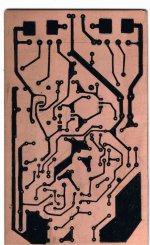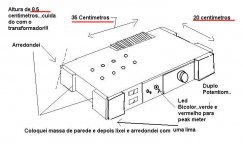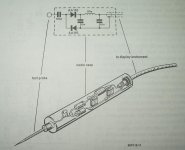MLAEN, Mike B designed this schematic, better than this one, 3 monthes ago.
What a surprise to see how he is humble and nice....he always trying to cooperate without openning the big mouth to say that he already made this one.
Not only he made, i did it also, and also another friend of us, John Mateus, we also submited the design to Hugh Dean to hear from him if the amplifier can sound good or not.
The amplifier, alike this one, a little bit increase in characterístics and features, was deeply tested in a computer ORCAD 9.1, and also constructed and evoluted, having 3 or 4 versions, each one better than the last one.
I am hearing this sound rigth now!
Mike B is using this amplifier now a days
John Mateus is using this amplifier today also.
I am deeply happy to see that i know very well how to select close friends, first was Hugh Dean form AKSA, and second John Mateus, and third big friend is Michael , the MIKEB in our forum.
He is expert in computer sciences, owner of his business and software designer...he joke saying...well, i can find a generator or make it by myself....hummm, better to find already done, will be faster!...can you perceive the guy capacity?
Humble, magnificent humble and capable as a hell to design circuits in class A, AB or even D class...discrete, with transistor, and working!
This amplifier, or alike this one, is his "son"...as he made it since the first part selection, since first stage....120 nigths working over it.
He has solution for all problems.... better, not to loose time, ask him the schematic already done, or, hear with attention what he say....as alike one movie, the one that already see the story end know very well whole thing.
regards,
Carlos
What a surprise to see how he is humble and nice....he always trying to cooperate without openning the big mouth to say that he already made this one.
Not only he made, i did it also, and also another friend of us, John Mateus, we also submited the design to Hugh Dean to hear from him if the amplifier can sound good or not.
The amplifier, alike this one, a little bit increase in characterístics and features, was deeply tested in a computer ORCAD 9.1, and also constructed and evoluted, having 3 or 4 versions, each one better than the last one.
I am hearing this sound rigth now!
Mike B is using this amplifier now a days
John Mateus is using this amplifier today also.
I am deeply happy to see that i know very well how to select close friends, first was Hugh Dean form AKSA, and second John Mateus, and third big friend is Michael , the MIKEB in our forum.
He is expert in computer sciences, owner of his business and software designer...he joke saying...well, i can find a generator or make it by myself....hummm, better to find already done, will be faster!...can you perceive the guy capacity?
Humble, magnificent humble and capable as a hell to design circuits in class A, AB or even D class...discrete, with transistor, and working!
This amplifier, or alike this one, is his "son"...as he made it since the first part selection, since first stage....120 nigths working over it.
He has solution for all problems.... better, not to loose time, ask him the schematic already done, or, hear with attention what he say....as alike one movie, the one that already see the story end know very well whole thing.
regards,
Carlos
A humble guy..i am sure, do not think that is something special.
But i guarantee that he is special in inteligence, and also very kind and humble.
The box i made to use his amplifier, i also have other boxes alike this one...to good sounding amplifiers.
regards,
Carlos
But i guarantee that he is special in inteligence, and also very kind and humble.
The box i made to use his amplifier, i also have other boxes alike this one...to good sounding amplifiers.
regards,
Carlos
Attachments
I add 330pF paralel to 10k and now it's normal...I set Ure to ~22mV and so far, ,so good! Hope it will stay there!! I'll let you know if everything is ok!
MikeB said:Fine !
But observe it, it might be undercompensated.
Okay, have fun listening !
Mike
I agree Mike, I would have played with the 10pF across C-B of that second long-tail-pair (man, I hate these schemas without component numbers. That's asking for trouble, as we have (again) seen. Why can't they take their own work serious?). Step it down from say 220pF until the situation is normal and than back up a few values to have a safety margin.
Jan Didden
THANKS!!!!!!!!!!!!!!!!!!!!
Ok, I hope this is finished!😎
I can't thank you enough for this!!
Milan, od kud si, ako se sretnemo imas cugu!!
PS
Janneman:
I don't want to do all that, ,what if I just put 220pF right away?
Ok, I hope this is finished!😎
I can't thank you enough for this!!
Milan, od kud si, ako se sretnemo imas cugu!!
PS
Janneman:
I don't want to do all that, ,what if I just put 220pF right away?
Re: THANKS!!!!!!!!!!!!!!!!!!!!
Sigh... No real DIY spirit!. Try 100pF, if you still have the problems, try 220pF. Or forget this all and keep it as it is.
Jan Didden
Mlaen said:Ok, I hope this is finished!😎
I can't thank you enough for this!!
Milan, od kud si, ako se sretnemo imas cugu!!
PS
Janneman:
I don't want to do all that, ,what if I just put 220pF right away?
Sigh... No real DIY spirit!. Try 100pF, if you still have the problems, try 220pF. Or forget this all and keep it as it is.
Jan Didden
Hey Mlaen, now the real fun begins !
I suggest you try some changes, like trying different sizes of caps,
also try to variate the B-C-cap, it's now 10pF, try 22pF or 33pF, and listen if sound changes.
An undercompensated amp looses some quality...
Mike
I suggest you try some changes, like trying different sizes of caps,
also try to variate the B-C-cap, it's now 10pF, try 22pF or 33pF, and listen if sound changes.
An undercompensated amp looses some quality...
Mike
Re: Re: THANKS!!!!!!!!!!!!!!!!!!!!
C'mon guys, give him a break! 🙂
I think this could be the right time to suggest building a simple HF probe for detecting amplifier oscillation like the one in the pic below. All caps are ordinary ceramic ones (input capacitor could be around 1nF). The diodes are universal germanium or low current schottky (BAT85). Metal case could be taken from an old aluminum marker. By connecting this probe to DC input on DVM, it is possible to detect audio and HF signals much above DVM's operating frequency range.
(the picture is the courtesy of "Build Your Own Electronic Test Instruments" - Elektor Electronics)
Regards,
Milan
janneman said:Sigh... No real DIY spirit!
MikeB said:.. now the real fun begins !
C'mon guys, give him a break! 🙂
I think this could be the right time to suggest building a simple HF probe for detecting amplifier oscillation like the one in the pic below. All caps are ordinary ceramic ones (input capacitor could be around 1nF). The diodes are universal germanium or low current schottky (BAT85). Metal case could be taken from an old aluminum marker. By connecting this probe to DC input on DVM, it is possible to detect audio and HF signals much above DVM's operating frequency range.
(the picture is the courtesy of "Build Your Own Electronic Test Instruments" - Elektor Electronics)
Regards,
Milan
Attachments
I'll play with amp more I promise 🙂D) but now that this is compleated I have some obligations in school and when I finish them I'll go improving the amp!
- Status
- Not open for further replies.
- Home
- Amplifiers
- Solid State
- Problems, again, with building the amp...





